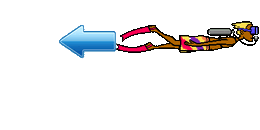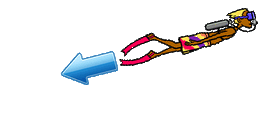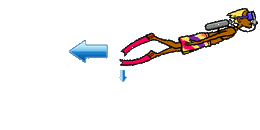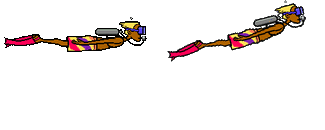Who hasn't admired those effortless divers. They're in perfect control and seem to use no energy during their dives, adjusting their depths magically, never creating a silt out, never scull and their air seems to last forever! Some say, this takes at least a hundred dives, but I've got a few lessons that will make you feel and look a lot better on your very next dive. This will be a multi-part discussion about how to master Neutral Buoyancy. They will be "The Importance of Horizontal Trim", "How to Establish Trim", "Bubble Management" and "Breathing Techniques". Consider this my Christmas present to all my students, past, present and future.
It's my personal opinion that these discussions and demonstrations should be a part of every open water class, but alas they are not. However, this thread is only to discuss the physics of trim and how it affects neutral buoyancy and not the importance of when or where it should be taught. PLEASE KEEP ON TOPIC.
Disclaimer... if the following picture epitomizes your concept of neutral buoyancy, then this thread may not be for you. In fact, it might just piss you off!

Almost everyone knows the physical law that for every action, there is an equal and opposite reaction. This is the beginning of understanding physics for divers. Don't worry, this won't be painful. I've taken a bit of time to create some animated GIFs to demonstrate what I'm writing about. As for testing your comprehension, your final exam will be on the reef.
For our purposes today, we'll be quantifying kick propulsion as a vector. A vector has both amplitude and direction which can be broken down to indicate both it's vertical and horizontal components. We're not going to worry about left or right in this discussion so we can keep this simple. All we are worried about is propulsion as it relates to vertical and horizontal components.
So, let's look at a nicely trimmed, horizontal diver. Of course, we're not talking about Christmas ornaments, but their attitude in the water, which should be mostly flat and horizontal.

Notice the propulsion vector being generated by the diver's kick. It's going straight behind him with no upwards or downwards element. This diver will control their depth by using their lungs rather than adjusting their propulsion angle and we'll cover how to do that in a couple of installments. Now let's look at a badly trimmed diver. We can see that his propulsion is not horizontal anymore but rather has a downward element to it.

While this is pretty as a picture, it's not giving us a real clue as to what is really happening. In order to do that, we are going to separate the resultant vector into its horizontal and vertical component vectors. They are smaller, but when added together, they become the bigger resultant vector seen above.
 Notice the small vector representing the downward propulsion happening here. The diver must compensate for this downward propulsion by adding more weight or letting out air in their BC to keep them moving horizontally. This is a slight angle as I've seen many, many divers with a 45o angle or worse! The larger the angle in regards to horizontal, the more force is being directed downwards rather than rearwards. That means you have to overweight yourself even more and that you're wasting a lot of energy pushing yourself up instead of forward like the horizontal diver. Good exercise, sure, but what happens when you stop? Here's a side by side comparison of these two divers at rest. The horizontally trimmed diver is on the left.
Notice the small vector representing the downward propulsion happening here. The diver must compensate for this downward propulsion by adding more weight or letting out air in their BC to keep them moving horizontally. This is a slight angle as I've seen many, many divers with a 45o angle or worse! The larger the angle in regards to horizontal, the more force is being directed downwards rather than rearwards. That means you have to overweight yourself even more and that you're wasting a lot of energy pushing yourself up instead of forward like the horizontal diver. Good exercise, sure, but what happens when you stop? Here's a side by side comparison of these two divers at rest. The horizontally trimmed diver is on the left.
 See? When the horizontally trimmed diver stops, he just stays there. Unfortunately, once the badly trimmed diver stops, he has no upward force to keep him neutral, so he starts to sink. This is where people start to scull with their hands or they add some air to their BC. Sculling and playing with your BC all the time are two major indicators that your trim is off: way off. That horizontal diver can just relax and look at whatever he stopped to admire. The badly trimmed diver has chased away whatever he wanted to look at with his flailing hands. Even worse, he gets the 'rototiller' award for kicking the crap out of the reef when he starts up again. While it's still your choice, it's pretty obvious from a physics standpoint that getting horizontal will improve your diving. You'll use less energy, which means your air will last longer and your drive will be far more enjoyable. I'll post the second installment in a day or two on how to establish horizontal trim. I bet you have a number of ideas already!
See? When the horizontally trimmed diver stops, he just stays there. Unfortunately, once the badly trimmed diver stops, he has no upward force to keep him neutral, so he starts to sink. This is where people start to scull with their hands or they add some air to their BC. Sculling and playing with your BC all the time are two major indicators that your trim is off: way off. That horizontal diver can just relax and look at whatever he stopped to admire. The badly trimmed diver has chased away whatever he wanted to look at with his flailing hands. Even worse, he gets the 'rototiller' award for kicking the crap out of the reef when he starts up again. While it's still your choice, it's pretty obvious from a physics standpoint that getting horizontal will improve your diving. You'll use less energy, which means your air will last longer and your drive will be far more enjoyable. I'll post the second installment in a day or two on how to establish horizontal trim. I bet you have a number of ideas already!
Comments, questions or insights? Please post them here: The Importance of Horizontal Trim Discussion
It's my personal opinion that these discussions and demonstrations should be a part of every open water class, but alas they are not. However, this thread is only to discuss the physics of trim and how it affects neutral buoyancy and not the importance of when or where it should be taught. PLEASE KEEP ON TOPIC.
Disclaimer... if the following picture epitomizes your concept of neutral buoyancy, then this thread may not be for you. In fact, it might just piss you off!
Horrible Diver Buoyancy/Trim
Almost everyone knows the physical law that for every action, there is an equal and opposite reaction. This is the beginning of understanding physics for divers. Don't worry, this won't be painful. I've taken a bit of time to create some animated GIFs to demonstrate what I'm writing about. As for testing your comprehension, your final exam will be on the reef.
For our purposes today, we'll be quantifying kick propulsion as a vector. A vector has both amplitude and direction which can be broken down to indicate both it's vertical and horizontal components. We're not going to worry about left or right in this discussion so we can keep this simple. All we are worried about is propulsion as it relates to vertical and horizontal components.
So, let's look at a nicely trimmed, horizontal diver. Of course, we're not talking about Christmas ornaments, but their attitude in the water, which should be mostly flat and horizontal.
Notice the propulsion vector being generated by the diver's kick. It's going straight behind him with no upwards or downwards element. This diver will control their depth by using their lungs rather than adjusting their propulsion angle and we'll cover how to do that in a couple of installments. Now let's look at a badly trimmed diver. We can see that his propulsion is not horizontal anymore but rather has a downward element to it.
While this is pretty as a picture, it's not giving us a real clue as to what is really happening. In order to do that, we are going to separate the resultant vector into its horizontal and vertical component vectors. They are smaller, but when added together, they become the bigger resultant vector seen above.
Comments, questions or insights? Please post them here: The Importance of Horizontal Trim Discussion
Attachments
Last edited:







